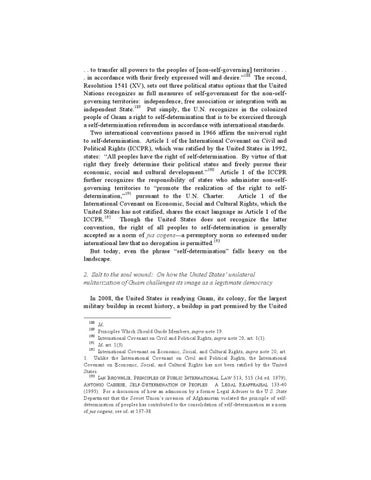. . to transfer all powers to the peoples of [non-self-governing] territories . . . in accordance with their freely expressed will and desire.”188 The second, Resolution 1541 (XV), sets out three political status options that the United Nations recognizes as full measures of self-government for the non-selfgoverning territories: independence, free association or integration with an independent State.189 Put simply, the U.N. recognizes in the colonized people of Guam a right to self-determination that is to be exercised through a self-determination referendum in accordance with international standards. Two international conventions passed in 1966 affirm the universal right to self-determination. Article 1 of the International Covenant on Civil and Political Rights (ICCPR), which was ratified by the United States in 1992, states: “All peoples have the right of self-determination. By virtue of that right they freely determine their political status and freely pursue their economic, social and cultural development.”190 Article 1 of the ICCPR further recognizes the responsibility of states who administer non-selfgoverning territories to “promote the realization of the right to selfdetermination,”191 pursuant to the U.N. Charter. Article 1 of the International Covenant on Economic, Social and Cultural Rights, which the United States has not ratified, shares the exact language as Article 1 of the ICCPR.192 Though the United States does not recognize the latter convention, the right of all peoples to self-determination is generally accepted as a norm of jus cogens—a peremptory norm so esteemed under international law that no derogation is permitted.193 But today, even the phrase “self-determination” falls heavy on the landscape. 2. Salt to the soul wound: On how the United States’ unilateral militarization of Guam challenges its image as a legitimate democracy In 2008, the United States is readying Guam, its colony, for the largest military buildup in recent history, a buildup in part premised by the United 188
Id. Principles Which Should Guide Members, supra note 19. 190 International Covenant on Civil and Political Rights, supra note 20, art. 1(1). 191 Id. art. 1(3). 192 International Covenant on Economic, Social, and Cultural Rights, supra note 20, art. 1. Unlike the International Covenant on Civil and Political Rights, the International Covenant on Economic, Social, and Cultural Rights has not been ratified by the United States. 193 IAN BROWNLIE, PRINCIPLES OF PUBLIC INTERNATIONAL LAW 513, 515 (3d ed. 1979); ANTONIO CASSESE, SELF-DETERMINATION OF PEOPLES: A LEGAL REAPPRAISAL 133-40 (1995). For a discussion of how an admission by a former Legal Adviser to the U.S. State Department that the Soviet Union’s invasion of Afghanistan violated the principle of selfdetermination of peoples has contributed to the consolidation of self-determination as a norm of jus cogens, see id. at 137-38. 189
